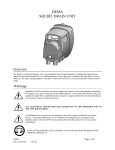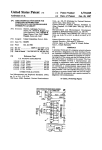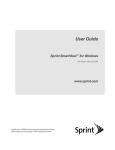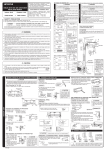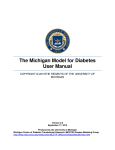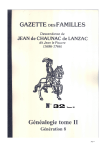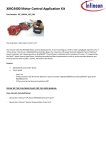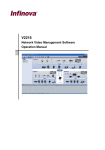Download llllllllllllllllllllllllllIlllllllllllllllllllllllllllllllllllllllllllllll
Transcript
llllllllllllllllllllllllllIlllllllllllllllllllllllllllllllllllllllllllllll US005121499A United States Patent [l9] [I1] [45] McCaskill et al. [54] METHOD FOR CONTROLLING THE ORDER OF EDITING CELLS IN A SPREADSHEE‘T BY EVALUATING ENTERED NEXT CELL ATTRIBUTE OF CURRENT CELL Filed: “Interactive Forms Positioning with Delayed Print“; 19, No. 8, Jan. 1977; p. 2821. “Form Log and Printing“; Cook et al; IBM Technical Disclosure Bulletin, vol. 18, No. ll. Apr.. 1976; p. 3552. Manual of "The Smart Spreadsheet with Graphics“. pp. l3-l92. l3-l94, copyright Jun., I984, published by In novative Software, Inc. William Doyle. in “Using Supercalc. The Next Genera tion" published by John Wiley 8: Son. Inc. 1985. Lotus l-2-3 User's Manual. 1983, pp. 109, H0, 157, 158. Jul. 25, 1991 341. Barlett et al., “Table Processing." Jan. 1984. IBM Tech nical Disclosure Bulletin, vol. 26, No, 8, pp. 4349-4354. Continuation of Ser. No. 739.368. Ma) 30. I985. aban doned. [51] Int. Cl.’ [53] US Cl. [53] ............................................ .. G06F 13/00 395/700; 364/DlG. 2: 364/4l9; 364/943: 364/9411: 364/9482 Field of Search .............. .i 364/4l9. 200 MS File. 364/900 MS File [56] 4.470.l29 9/1984 4.520.457 S/IQBS Haglcr et al. 4.586.l58 4/l986 364/900 . .. 364/900 4.633.430 12/1986 Cooper .... .. 4.646.250 Childress ........................... .. 364/5l8 364/900 FOREIGN PATENT DOCUMENTS 0075742 9/1982 Attorney. Agent. or Firm~Whitham 8: Marhoefer [57] ABSTRACT A mechanism allows for programming the order of cells of~ the spreadsheet may be provided with a "next cell" Disbrow et a]. .................. .. 364/900 Brandle ....... .. Primary Examiner-Thomas C. Lee Assistant Examiner—L. Donaghue for an operator to enter data in a spreadsheet. Each cell References Cited U.S. PATENT DOCUMENTS 2/1987 Jun. 9, 1992 Colnen et a]: IBM Technical Disclosure Bulletin. vol. Related US. Application Data [63] 5,121,499 Barker et al: IBM Technical Disclosure Bulletin. vol. 27. No. 108. Mar. 1985; p. 6002. Inventors: Rex A. McCasltill; Beverly H. Maehart; Harry E. O‘Steen, all of Travis County. Tex. [73] Assignee: International Business Machines Corp., Armonk. NY. [211 Appl. No.; 735,698 ill] Patent Number: Date of Patent: attribute. and these attributes as well as other attributes for the cells are stored in a table. The “next cell" attri bute may be a constant. such as the name of the next cell, or it may be a logic expression so that the next cell to be edited can be different depending on some condi tion. When the operator presses the NEXT CELL key, the "next cell" attribute is searched by accessing the attribute table. and if a “next cell" attribute is found. it European Pat. Off. . is evaluated to determine the next cell to be edited. OTHER PUBLICATIONS "lmplicit Object De?nition In a Multiple Data Editor"; l 6 Claims, 7 Drawing Sheets I, 20 LUCHE CURRENT CELL lllRIBUTES HM‘ lHLNULCELLlTTRlBUTE (.ALL tvituitt_um_cttt lRETllllltS EVMUITEQJULEELL l “U005 ltEtT_EELL = tvituitto_um_cttt = - Minn ' US. Patent DOVE COPY SHOW CREATE June 9, 1992 GET . . . . DESCRIBE . . . . Sheet 1 of 7 . . . . . . . . . . . . . . . . . . . . . . . . . . . . . 5,121,499 . . . . . . . . . . . . Text eppenre in tho document Iol loved by the (Male of numbere . The number‘ ere per t of e opreedeheet /3 the’ H. in fact. e diHerent type of do“ in the document. AHer the epreedeheel more text could eppeer. ov per hepe e graphic dielreln or nay of e vet iety of the ineny di?erent object types. F161 . . . . . . . . . . . US. Patent IOVE COPY SH“ CREATE June 9, 1992 GET . . . . DESCRIBE . . . . Sheet 2 0f 7 . . . . . . . . . . . . . . . . . . . . . . . . . . . . . 5,121,499 . . . . . . . . . . . Text eppeere in the document lot lowed by the tehle of numbers. The numbere ere pert at e epreedeheet thet ie. In Iect. e dIHerent type of dete in the document. [I r5 Alter the epreedeheet more text could eppeef. or per hepe e grephic dtegrem or eny of e variety at the neny dHferent object typee. H62 . . . . . . . . . . . . US. Patent IOVE COPY 8H“ CREATE June 9, 1992 GET . . . . . . DESCRIBE . . Sheet 3 of 7 . . . . . . . . . . . . . . . . CELL Tent eppeere i of number: . the! ‘e . in 7 teble ‘I’ \ 1e PROTECT: thee! OFF ON Hoe document . .F_ NEXT can / 6 [8/ i If ter the epreedeheet more text can“ eppeer . hepe e graphic diegrem or any of e ver iely of 6i Herent objec! typee . H63 or per the meny 5,121,499 US. Patent MOVE COPY SHOW CREATE June 9, 1992 GET . . . . . . DESCRIBE . . 5,121,499 Sheet 4 of 7 . . . . . . . . . . . . . . . . . . . . . . . . . . . . . . . . . . . . . . . . CELL Text appoarl i \lblo of T about lumbar: . that H . in fl PROTECT: OFF ON Hn document. NEXT CELL=B§§§ 5 9 I . — A FLT / 10 f A! In the sproldslnct more to“ could lppllr . hapl I graphic diagram or any 0! I var loly of di?oront obllct IypQI. HG or por tho Inlay . . . . . . . . . . . . US. Patent June 9, 1992 Sheet 5 of 7 5,121,499 POS|T|ON T0 HRST CELL TO PROCESS l6 \ NORMAL PROCESSING HND_NEXT_CELL (RETURNS NEXLCELL ) n ERROR YES IIS POST ERROR MESSAGE N0 n9 \ CURRENT_CELL== NEXLCELL END FIGS US. Patent June 9, 1992 Sheet 6 of 7 5,121,499 1 START ) [20 LOCATE CURRENT cm ATTRiBUTES FIND THE_NEXT_CELL_ATTRIBUTE CALL EVALUATE__NEXT_CELL (RETURNS EVALUATED_NEXT_CELL) RET__C0DE : /24 RET_CODE := "vnuo" mum 1: EVALUATEDJEXLCELL END FIGB " INVAUD " U.S. Patent June 9, 1992 5,121,499 Sheet 7 of 7 1 /26 CHECK THE REMINDER OF THE STRING FOR A VALLO CELL SYNTAX EVALUATE BOOLEAN EXPRESSION /32 SET THE RETURN COOE TO'VALID CELL NOT FOUND" 27 ERROR YES CALL NO EVALUATE_NEXT_CELL WTTH STRING AFTER THE "ELSE" CALL [29 EvALUATE_NExT_cELL WITH SET THE RETURN CODE TO "VALID CELL NOT FOUND" STRING BETWEEN "THEN" ANU "ELSE" 36 [25 \ RETURN TRE CELL NANE PASS RAcN RETURN PARANETERs FROM EVALUATE_NEXT_CELL sET THE RETURN CODE To ‘VALID CELL FOUND" FIG] END I 5,121,499 2 described and. if data is changed or deleted in the METHOD FOR CONTROLLING THE ORDER OF EDITING CELLS IN A SPREADSHEET BY EVALUATING ENTERED NEXT CELL ATTRIBUTE OF CURRENT CELL course of editing the spreadsheet. all computations that are effected by the changes or deletions are automati cally recomputed. In existing spreadsheets. however. there is no method for programming the order of cells for an operator to enter data. In a large. complex model. it is desirable (even for the originator of the model) to direct the user to the cells in which data is to be entered and to specify CROSS REFERENCE TO RELATED APPLICATIONS This is a continuation of Ser. No. 739,368 ?led May 10 30, I985, abandoned. the order of entry. By cells. what is meant the various The invention disclosed in this application is related intersections of rows and columns of the spreadsheets. in subject matter to the inventions disclosed in the fol lowing patent applications which are assigned to the assignee of this application: Ser. No. 06/645,622 ?led Aug. 30, 1984. by Barbara These may be of various sizes as de?ned by the origina tor of the model to accomodate the expected number of 5 characters that may need to be entered into a particular A. Barker and Rex A. McCaskill for "Superblock Structure in a Multiple Data Editor”, now U.S. Pat. No. 4.723.210; cell. SUMMARY OF THE INVENTION It is therefore an object of the subject invention to provide a technique for programming the order of cells Ser. No. 06/645.620 ?led Aug. 30. I984. by Barbara A. Barker and Irene H. Hernandez for "Implicit Cre ation of a Superblock Structure", now US. Pat. No. 4.739.477; and Ser. No. 06/645630 ?led Aug. 30. I984. by Barbara method to direct the user to the cells in which to enter A. Barker. Irene H. Hernandez and Rex A. McCaskill data and to specify the order of entry of the data in a for "Editing ofa Superblock Structure". now US. Pat. No. 4.72.3.2! l. spreadsheet program. The disclosures of the foregoing patent applications are incorporated herein by reference. for an operator to enter data in a spreadsheet. It is another object of the invention to provide a It is a further object of the invention to provide the spreadsheet editor ofa multiple data editor with a way in which the order of data entry and/or editing of cells in a spreadsheet can be speci?ed by the originator ofthe TECHNICAL FIELD 30 model represented by the spreadsheet. The present invention generally relates to data edi According to the invention, a mechanism is provided tors and. more particularly. to a technique for linking a to link a cell to the "next cell“ to be edited. The value cell in a spreadsheet to the "next cell" in the spreadsheet placed in the “next cell“ parameter may be a constant for facilitating data entry and editing in a spreadsheet application. The invention has particular application in a multiple data editor characterized by a superblock construction containing two or more diverse object sets; however. the technique according to the invention can be advantageously applied to spreadsheet applica such as the name of another cell However. the value may also be a logic expression so that the next cell to edit can be different depending on some condition. This mechanism can be used to set “edit paths“ that can merge. cross, or follow any pattern desired. Multiple tions in general and is therefore not limited to multiple 40 paths can also be de?ned. By using a system de?ned indicator (such as a speci?c keystroke) to go to the next data editors. cell, the operator can move through the spreadsheet on DESCRIPTION OF THE PRIOR ART a path. or simply choose to use the keys that move to Spreadsheet applications or programs have come into adjacent cells. wide use on personal computers and are used for bud 45 geting. ?nancial forecasting. pro?t—and-loss statements BRIEF DESCRIPTION OF THE DRAWINGS as well as many other accounting applications. The The foregoing and other objects. aspects and advan tages of the invention will be better understood from “electronic spreadsheet" generated by such a program can be considered to be analogous to an accountant‘s ledger sheet having many rows and columns in which data are entered. Certain columns may be mathemati cally linked so that data entered in a row of one column and data entered in the same row of another column generate data in that row of yet another column. Thus, for example. the ?rst column might be an interest rate, the second column might be the principal amount, and the third column might be the interest amount com the following detailed description with reference to the drawings, in which: FIG. 1 illustrates the screen of a spreadsheet applica tion that has a command area and a document area; FIG. 2 illustrates the highlighting of one of the cells in the document area of the screen shown in FIG. 1; FIG. 3 shows the result of selecting the DESCRIBE command from the command area of the screen shown puted by multiplying the interest rate times the principal in FIG. 1; might be summed to provide total amounts. This, of FIG. 5 is a ?ow chart showing the main procedure according to the invention; FIG. 6 is a ?ow chart showing the procedure for the FIG. 4 shows the result of selecting the NEXT amount. Further. the amounts in the principal amount column and the amounts in the interest amount column 60 CELL property in the screen shown in FIG. 3; course. is but a simple example to illustrate the use of a spreadsheet in general. and the description is equally applicable to hand entry of data in a ledger sheet or the data entered by a keyboard into the spreadsheet applica tion. The advantage of the latter is that the computa tions. once de?ned by the user, are all automatic as data is entered into the ?rst two columns in the example subroutine FIND_NEXT_CELL which is called from the main procedure; and FIG. 7 is a flow chart showing the procedure for the subroutine EVALUATE_NEXT_CELL which is called from the subroutine FIND_NEXT._CELL. 3 5,121,499 DETAILED DESCRIPTION OF THE PREFERRED EMBODIMENT OF THE INVENTION In the multiple data editor described. for example. in 4 directions relative to the currently edited cell. The assumption for the “Next Cell" attribute made for this description is that the attribute is a free key ?eld. as shown in FIG. 3. in which the operator can enter an expression that. when properly evaluated. indicates the the above-referenced US. Pat. No. 4.723.210. table is next cell to edit. the name given to an object set that consists of a sym The "main" procedure below is representative of a spreadsheet program that would use the “?nd_nex metrical arrangement of cells which form a rectangular pattern consisting of rows and columns on the display. t__cell" procedure. This procedure is written in Pro Thus. a table object set is de?ned as a collection of cells O gram Design Language (PDL) from which source and arranged in rows and columns. and such an object set object code may be readily derived by a programmer of includes a spreadsheet as de?ned above. A cell is the ordinary skill in the art. smallest object in the table object set. and the contents of a cell may include formulas. calculations. numeric values and textual data. As implemented in the multiple 5 data editor. the invention is practiced by providing a NEXT CELL key which allows the user go to the cell named in the "Next Cell“ attribute of the current cell. In designing the model for the spreadsheet, the origina 20 tor supplies this attribute. FIG. I illustrates the screen of a spreadsheet applica tion that has a command area 1 and a document area 2. Inside the document area is text data 3 followed by spreadsheet data 4 which. in turn. is followed by more text data. It will be observed that the spreadsheet data is represented by an array of rectangles. These rectangles represent the cells of the spreadsheet as described above. FIG. 2 illustrates the highlighting of one of the cells of the spreadsheet data. In this ?gure. the high lighting is represented by a cell 5 drawn with double 30 lines; however. those skilled in the art will understand that highlighting on a display screen can take any of a number of different forms including reverse video. in creased intensity. or a change in color. The highlighted PROCEDURE main Ill.It.‘.‘GO'I'OOIII'IIOOUUOO'U'I'IIIII'I‘QO'Q" ‘ PURPOSE: Control the order of editing cells in ' ' the spreadsheet. ' .‘OGOOI0.00I‘OOI'O'OO.IO".I‘IO'QOC'IOO‘IOOIOOO. Position the operating point to the ?rst cell to process. WHILE editing is to be done DO Edit the current cell. IF edit next cell is requested THEN Call FIND_NEXT_CELL If no error in ?nding next cell THEN Position operating point to the cell returned by FIND_NEXT_CELL. ELSE Post an error message indicating that the "next cell" expression is in error ENDIF ELSE Process depending on method to use when "edit next cell" is not requested ENDIF ENDWHILE cell is in the second row and second column and has the 35 FIG. 5 is the flow chart for the main procedure. This a default name of R2C2. meaning that the cell is located is the procedure that is in effect at the time the spread in row 2 and column 2. FIG. 3 shows the result of se sheet is being edited. The ?rst cell to be processed, as lecting the DESCRIBE command after an object. in determined by the system. is used as the cell to which this case a cell of the spreadsheet. has been selected. A the operating point is initially positioned, as indicated pop-down menu 6 is presented with the properties of by block 11. The initial condition of spreadsheet editing the selected object. In this illustration. two ofthe types is that this ?rst cell is to be edited. so the system deter of properties are shown. Some properties such as the mines that there is more editing to do. as indicated by PROTECT property 7 for a cell are speci?ed by select decision block 12. and begins the process of editing the ing one of several options. Other properties such as cell in block 13. After the cell has been edited, the sys NEXT CELL 8 are speci?ed by a free-key input ?eld 45 tem must determine whether the next cell to edit is that must then be interpreted by the program. FIG. 4 identi?ed by the Next Cell property ofthe current cell. shows the result of selecting the NEXT CELL prop This is indicated by decision block 14. If not, then as erty and typing in the speci?cation R4C3 at 9. This indicated in block 16. the normal processing determines speci?cation indicates that when the system designated the next cell to edit. which could be dependent on the method for moving to the next cell is used. the next cell direction of cursor movement or an explicit selection by to edit is cell 10 in row four. column three. pointing. The process loops back to decision block 12. The following is a pseudocode description of an im and it may be that at this time editing is complete. Ifthis plementation of "cell linking“. This description repre~ sents the logic of the implementation. The assumptions were the case. the process exits. However. on the other butes associated with it. Examples of attributes are pro in decision block 17 to see if an error condition exists. If not. then the identi?ed cell is made the current cell as hand, if the Next Cell property is found in decision made for the purpose of this description are that a 55 block 14. then a procedure is called to identify which spreadsheet program has been implemented in such a cell is to be edited next. This is the function indicated in way that each cell in the spreadsheet has certain attri' block 15. After the procedure is executed, a test is made tection. adjust. numeric formatting. and the like. As is well known in the data processing arts. such attributes are part of the data structure that de?ne the cell. The particular attribute that is required for this invention is indicated in block 19. If an error occured. an error message is posted as indicated in block 18, and the cur rent cell remains unchanged. In either case, the proce dure loops back to decision block 12. the "Next Cell" attribute mentioned above, and this too is part of the data structure of the cell. This attribute is The PDL code for the procedure FIND_NEX used to indicate what cell should be edited (or made 65 T_CELL is listed below. active) next when the NEXT CELL key is pressed by the operator. This is different from using cursor motion keys to indicate that the next cell to edit is in one of four PROCEDURE FIND_NEXT_CELL 5,121,499 -continued I‘II...It'llD.ll‘I‘I...I...Il‘III."II.’I’."U.........U...D ' PURPOSE ' ' INPL'T ‘ ' OL'TPL‘T ' O Find the next cell b) using the "next ' Cell" attribute ' Current cell location in the ' spreadsheet. ' Return code tndtcating ifa valld ' next cell vias found The next cell ' to edit Q II'.‘IIOO'IIIO'IIII'IO'OIIIII-Q...II.‘IIOOOI'O'IOO'II'IIIC.‘ Locate current cell attributes Find the "next cell" attribute Call EVALUATE._NEXT._CELL 6 The flow chart for the procedure FIND_NEX T_CELL is shown in FIG. 6. This procedure is called to determine the next cell to edit as speci?ed in the Next Cell property ofthe current cell. The current cell attri butes are located and the Next_Cell attribute is located as indicated in block 20. The value for this attribute is a string that was speci?ed by the operator through key ing. pointing or some other means. This string is evalu ated by calling the EVALUATE_NEXT_CELL pro cedure to parse the string and derive the identity of the next cell to edit as indicated in block 21. This procedure returns an error indicator which is tested in decision block 22. If the error indicator is true, then an invalid return code is returned to the calling program as indi cated in block 23. On the other hand, ifthe error indica tor is false, the identi?ed cell can be returned to the calling program as indicated in block 24. IF a valid next cell found THEN Set return code to "valid cell found"; Set next cell to edit to cell returned from E\'ALUATE_NEXT_CELL; ELSE Set return code to "valid cell not found"; ENDIF The PDL code listing for the procedure EVALUATE_NEXT_CELL is listed below. PROCEDURE E\"ALUATE_NEXT_CELL onenoose...‘no.0-000......nuance...cocoons.‘noon.cannons.oon...nooonnooooeeoooenennoo 0 PURPOSE INPL'T: OL'TPL'T' Evaluate the "next cell" attribute expression Pointer to and length of the expression Return code. SYNTAX. Cell identi?er (if valid cell found) The following is the set of syntax 0e - Valld cell found - Valid cell not found diagrams for the expression. Expressmn; 0 Cell T Q If Statement If Statement: 0 .! ' ———> IF -—-> Boolean Expression 0 THEN% Expression j -—>ELSE —>E1presston J 0 Boolean Expression: -——9Simple Expression 0. Simple Expression Simple Expression: Til %_ V >Term [- Term l 0 5,121,499 -continued Term ——9Factnr L V Faclnr ' 6 a n 0 l o 0 .IQO'’ Factor ———-9 L’nslgncd Constant at %B0Olean Expression -——>| —' NOT -——--> Factur Unstgned Constant I c l 0 0 c u o a -—-%lnteger Number ———--t-% ———>Rc.1l Number % I Character Integer Number Real Number I > Dtgu I > Dtgtl I ] V L E Dlglt -— Cell o % R -% R0“ Number —> c -_9 Col Number -_-> IF the expression with an "If statement" THEN Evaluate the bOOlean expressmn IF there ts a syntax error m the boolean expression THEN set the return code to vahd cell not found ELSE IF the boolean expression evaluated "true" THEN call EVALUATE__NEXT_CELL with the string between the "then“ and “elsc‘~ ' Puss back the return parameters returned from EVALUATE_NEXT_CELL ELSE Call EVALUATE_NEXT_CELL with the stnng after the "else" Pass back the return parameters returned from EVALUATE_NEXT_CELL ENDIF ENDIF ELSE Check the remainder of the string for a valid cell syntax IF I valid cell syntax we: found THEN return the cell name Set the return code to valid cell found ELSE Set the return code to vll‘ld cell not found ENDIF 5,121,499 10 -continued END“ accessing an attribute editing function of said spread sheet application program; entering data in ?elds of the data structure defining The flow chart for the EVALUATE_NEX T_CELL procedure is shown in FIG. 7. This proce dure examines the input string to determine the cell to be identi?ed according to the syntax rules of the Next Cell attribute. The syntax is described in the PDL code given above for this procedure. First, a test is made in the "next cell" attribute of a selected plurality of cells of the spreadsheet to de?ne said order of data entry to said selected plurality of cells of the spreadsheet; decision block 25 to determine if an "IF Statement“ is contained in the string. lfthere is not an “lF Statement“ responding to a next cell command from the user by in the string. then the remainder is examined in block 26 for valid syntax of a speci?c cell. In decision block 27, current cell to determine the next cell to edit; and evaluating the entered "next cell" attribute of the moving to the next cell identi?ed by the "next cell" a test is made for a valid cell syntax. lfa valid cell syntax attribute. is not found, then a return parameter is passed to the 2. The method recited in claim 1 wherein the "next calling program indicating that a valid cell was not cell" attribute is a constant identifying a predetermined found as indicated in block 29. On the other hand, if a different cell in the spreadsheet. valid cell syntax is found, then a return parameter is 20 3. The method recited in claim I wherein the “next passed to the calling program indicating that a valid cell cell“ attribute is logic expression, said method further was found and the name ofthe cell as indicated in block 28. In the case where the "lF Statment" is found in comprising the computer performed step of evaluating decision block 25. the boolean expression of the state ment is evaluated as indicated in block 30. Since the expression may be in error, a test is made in decision next cell to edit in the spreadsheet. said logic expression to determine the identity of the 4. The method recited in claim 1 further comprising the steps of: accessing a first cell of said plurality of selected and edited cells; locating cell attributes of a currently accessed cell; evaluating said "next cell" attribute and, upon entry of data in said currently accessed cell, moving to a cell identi?ed by said "next cell" attribute: and block 31 so that a return parameter can be passed to the calling program to indicate that a valid cell was not found as indicated in block 32. If no error occured. then the expression evaluated is either True or False. This is tested in decision block 33. If the expression is True. then the following portion of the string between the THEN and ELSE parts of the IF statement is to be evaluated recursively by this same procedure as indi cated in block 35. In the case where the expression is 35 repeating said locating, evaluating and moving steps False. the portion of the string after the ELSE is to be 5. A computer implemented data entry method for an until data has been entered in all of said selected cells. evaluated as indicated in block 34. In either case. the electronic spreadsheet running on a computer compris return parameters from the recursive call are returned ing the steps of: as the parameters to the calling program as indicated in providing the cells of the spreadsheet with a "next block 36. 40 cell" attribute as part of the data structure which While the invention has been described in terms ofa de?nes the cells; preferred embodiment. those skilled in the art will rec accessing an attribute editing function for the spread ognize that the technique employed may be modi?ed sheet application program for each ofa plurality of selected cells of the spreadsheet; and used without departing from the scope of the inven tion. 45 inputting data in the "next cell" attribute data struc Having thus described my invention. what I consider ture for said selected cells, which data de?nes an novel and desire to secure by Letters Patent is set forth order of data entry for said selected cells of the in the following claims: 1. A computer implemented method of setting up a spreadsheet application program on a computer, said 50 application program displaying a spreadsheet compris ing intersecting rows and columns forming cells of the spreadsheet, each of said cells being de?ned by a data structure accessed by said spreadsheet application pro gram and evaluated by said computer for the processing spreadsheet; accessing a ?rst cell of said plurality of selected cells; locating cell attributes of a currently accessed cell; evaluating said “next cell" attribute and, upon entry of data in said currently accessed cell, moving to a cell identi?ed by said "next cell" attribute; and repeating said locating, evaluating and moving steps until data has been entered in all of said selected cells. 6. The data entry method for an electronic spread sheet recited in claim 5 wherein said data which de?nes program is directed from a current cell to a next cell of an order of data entry comprises for at least one of said the spreadsheet for the purpose of making entries int eh 60 selected cells a Boolean expression which, when evalu cells of the spreadsheet in an order in which data is to be ated, identi?es ?rst or second cells of said plurality of entered comprising the steps of; selected cells of the spreadsheet, said method further 55 of displayed data, wherein the order of data entry to the cells of the spreadsheet by a user is controlled by the computer so that a user of the spreadsheet application providing in said spreadsheet application program at least some of the cells of the spreadsheet with a "next cell" attribute as part of the data structure 65 which de?nes the cell and which is evaluated by said computer to determine the next cell after the current cell for the entry of data; comprising the steps of: evaluating said Boolean expression ; and if said Boolean expression is true moving to said ?rst cell; otherwise. moving to said second cell. ’ i ’ Q ‘













